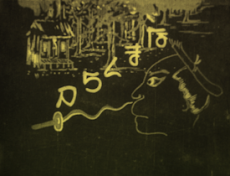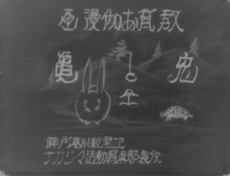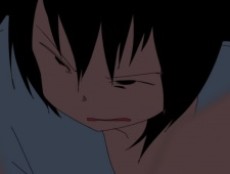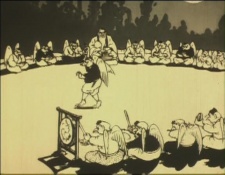KATSUDOU SHASHIN
MOVIE
Dubbed
SOURCE
ORIGINAL
RELEASE
January 1, 1907
LENGTH
1 min
DESCRIPTION
The film consists of a series of cartoon images on fifty frames of a celluloid strip and lasts three seconds at sixteen frames per second. It depicts a young boy in a sailor suit who writes the kanji characters "活動写真" (katsudou shashin, or "moving picture"), then turns towards the viewer, removes his hat, and offers a salute. The fragment was discovered in 2005, having been purchased with a private collection in Kyoto. The film was likely created between 1905 and 1911. If so, the film may be the oldest known piece of animation from Japan.
(Source: Wikipedia)
REVIEWS

zombiepegasus
50/100As the first anime ever this doesn't have much substance, but it's valuable anyway.Continue on AniListAt only three seconds long, the shortest anime ever made, this was intended to be short and sweet, but not because the story didn’t need to be long. This was created around the year 1910 when the concept of animation had only been recently introduced to Japan and so as a still experimental storytelling style they hadn’t developed a cheap enough way to create more animation than this. With 50 frames in total this was as much as they could muster and the end of it doesn’t even look like it’s complete, but considering its age this is acceptable. After all, this wasn’t intended to be treated as an anime since anime didn’t exist at the time, this was just meant as both a project and a feat; a mark that animation was possible and a feasible way to show stories.
This doesn’t have so much of a story as just a thing that happens. A boy writes 活動写真 meaning “moving picture” on an unknown background, likely a wall but seeing the way he’s dressed I assumed it could have been a boat, and then bows towards the audience, lifting his hat. Even calling this slice of life would be a stretch since it’s such a small slice. We aren’t told anything about this boy’s backstory or why he’s writing it, nor why he’s wearing a sailor uniform, which has now come to be associated with the female school uniform in Japan. At the very least there certainly isn’t any filler since there isn’t any room for it, but there also isn’t anything that would need filling anyway. Any kind of real story you could get out of this would be more speculation than what’s actually presented in the film.
The art style is unique to say the least. They definitely didn’t have much of a way to even save an animation like this and although it’s understandable that it would be made with a camera as computers were decades away from even existing, let alone being advanced enough to make animations on, but I still do consider camerawork to be shoddy. What was found in 2005 as a celluloid strip so we can assume the camerawork was done then, but it could also be that the strip was intended to be used with a projector or otherwise not be recorded and shown in real time at a festival of some sort making it hard to turn into a recording, which is understandable yet unfortunate. After all, how were they to know that over a century later caucasian neckbeards would be watching this on computers and smartphones? The art is more than merely dated, it really doesn’t have much going on and was clearly made as cheaply as possible, which plays more into the fact that they only managed to make 50 frames. The art isn’t entirely awful, but it’s certainly simple and not very pretty. It’s as good as they could make at the time, though.
The sound is sort of non-existent, which is reasonable since there isn’t really any need for sound. It is a celluloid strip, after all, and so there wasn’t sound recorded with it. When it aired it would be safe to assume they had a band playing as silent films usually do, but since it’s only three seconds long they either might not have or would have repeated the clip several times in order to give people appropriate time to properly enjoy and appreciate it. I’m over a century too late to hear whatever would have played with it, if anything, so I can’t comment on how good the music was, but live music tends to be good. This is a part of the score that will remain a mystery as lost media simply due to the fact that it was intended to be watched live rather than recorded.
Just as any other story or animation would this does have a character, but we aren’t shown what his personality is. He writes “moving picture” on an unknown surface while wearing a sailor uniform and then bows to the audience as if this was some sort of performance. He could have been told to do this and this was all just some act where his uniform only serves as a costume he was forced into, but it could also be that he is a stand-in for the creators and he bowing to the audience who have come to see this moving picture. The second one would be breaking the fourth wall, which doesn’t happen too much in anime, but we’re also given no concrete evidence that this is the intention. This theory doesn’t explain the sailor uniform, though, but when you look at it closely it seems to be the most logical explanation. Another interpretation would be that it is a schoolboy who wears that as his school uniform and he wrote it not to tell the audience what they’re watching but rather just as a demonstration of his Japanese skills. All of these would lead to different personalities for our protagonist and there isn’t enough information in the anime to know which one is the most true. This isn’t a problem with the anime so much as it is a problem with its length. They could only afford to make 50 frames and they chose to draw them close enough together that it presents relatively fluid animation rather than showing a more in depth story with a lower frame rate which would end up being more like a manga than an anime.
I enjoyed watching this mostly for the historical value in knowing where anime came from. It is the first anime, after all. I would have to say that I found more enjoyment in writing this review than I had in watching the anime itself, but that’s mostly due to its short screen time and how old it is. I respect it greatly for the path it paved for all the anime that came after it, but I wouldn’t consider it to be a good anime itself. It certainly wasn’t painful to watch, though, and so I can honestly say I enjoyed every second of it.
I’d have to say that it belongs in an art gallery more than anywhere else, but it’s still a great mark of Japanese achievement and I would consider this to be a must watch for all anime fans.

AnimeYasna
100/100Watch a boy take off his hat, the 3-second anime that changed EVERYTHING. You won't believe the twist!Continue on AniListAh, Katsudou Shashin, the anime that started it all. Literally. (Well that is still around in watchable form) With its dazzling 3-second runtime, this masterpiece really respects your time. No need to worry about long-winded fillers, character development, or any development for that matter! Who needs a plot when you have the raw vibes of 50 frames of pure cinematic history?
Plot Summary:
I present to you: A boy removes his hat. That's it. No shadow clones, no shouting about friendship, just straight-up hat etiquette. I haven't seen a hat move this dramatically since Indiana Jones.The animation is so clean, so detailed, you can almost feel the existential dread of that hat leaving his head. You’ll be asking yourself, “Why did he take the hat off? What did the hat do to deserve this? Is he battling the forces of evil, or is this a statement about class consciousness?” I personally went down a two-hour YouTube rabbit hole on the philosophical implications of headwear in early 20th-century Japan.
Characters:
Boy with Hat: Easily in the top 10 anime protagonists of all time. Sure, he doesn’t have a tragic backstory or any dialogue, but his energy is undeniable. The way he flicks his wrist as he doffs his cap? Absolute chef’s kiss. Move over, Naruto, there’s a new boy in town, and he’s coming for the Hat-ake clan.The Hat: Probably the most underrated character in the history of anime. This hat has been through a lot: dust, gravity, social expectations—it's seen things. I'd even argue it's the true protagonist. The emotional journey of this hat rivals that of any Gundam or Titan. Where does it go after leaving his head? That’s the mystery. Maybe it ends up in a spinoff series.
Animation:
Forget Demon Slayer’s sword-fight choreography, Attack on Titan’s colossal animation budget, or even Your Name’s stunning visuals. Katsudou Shashin proves you can do it all with the essentials: a boy, a hat, and some paper. CGI? Nah. Just raw, hand-drawn artistry. You’ll barely believe this was made in 1907. It’s like the O.G. Studio Ghibli, but without all the plot and magic. What more could you ask for?Soundtrack:
There isn’t one, but that’s how avant-garde this show is. Every great anime theme you love—whether it’s Attack on Titan’s operatic choirs or One Piece’s earworm openings—owes its existence to this bold choice of complete silence. A revolutionary move, indeed.Final Thoughts:
"Katsudou Shashin" is a cinematic juggernaut that redefines the very notion of storytelling. If you're the kind of person who needs high-energy fight scenes, complex character arcs, or 20-minute episodes, you simply don’t get it. But if you’re ready to embrace the minimalist, blink-and-you-miss-it brilliance, buckle up and hold on to your hats... because they're about to get removed.Move over Attack on Titan—this anime truly attacks the feels.
SIMILAR ANIMES YOU MAY LIKE
 MOVIE ComedyNamakura Gatana
MOVIE ComedyNamakura Gatana
SCORE
- (2.5/5)
MORE INFO
Ended inJanuary 1, 1907
Favorited by 12 Users



